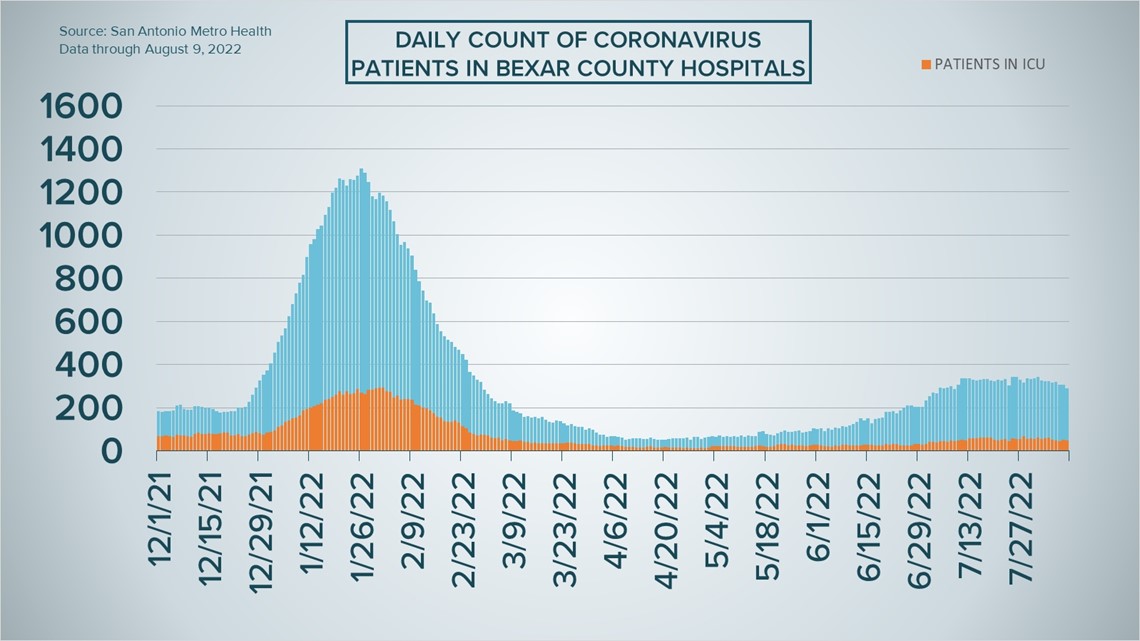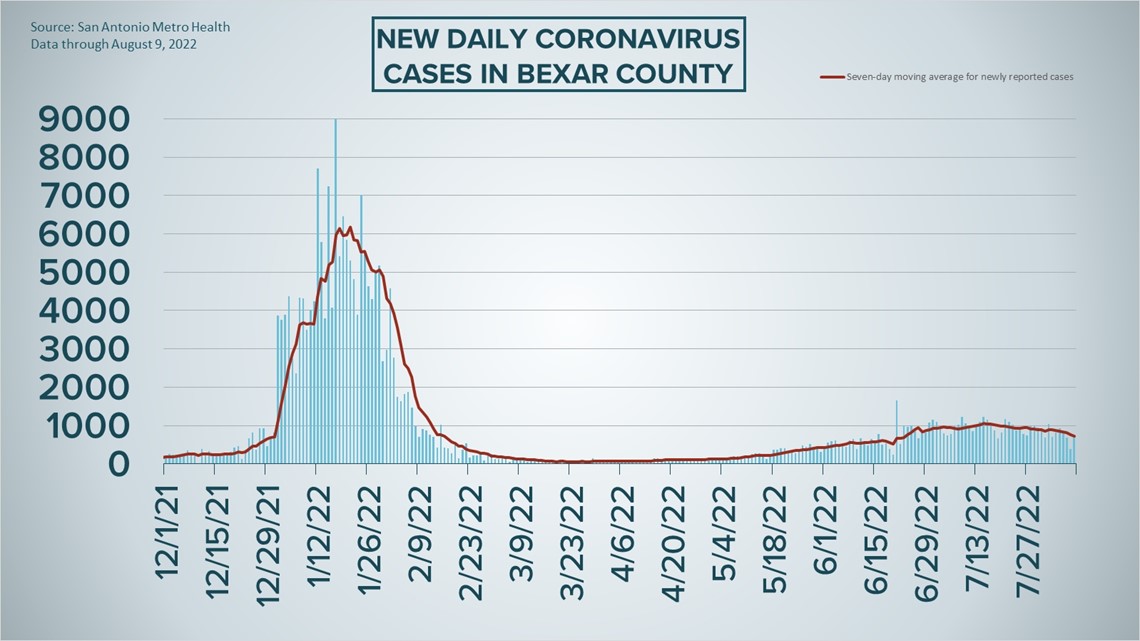SAN ANTONIO — Coronavirus hospitalizations in the San Antonio region have dipped below 300 for the first time in a month, and August is off to a more stable start in regards to new infections following a wave that began in mid-June and may have peaked in late July.
Bexar County has averaged 715 new COVID-19 diagnoses a day for the past week, compared to nearly 900 for the seven days prior. That trend has tugged the seven-day case average down further every day for a week as the community recovers from a brief summer wave that was its worst since January's drastic omicron-fueled spike.
There were 289 coronavirus patients in local hospitals Tuesday, down from 307 on Monday and 327 a week ago. Of those 289 patients, 47 were in intensive care and nine were using ventilators.
Just under 12% of staffed hospital beds were open to take a patient, a mark the region has hovered around for several weeks.
Despite the better outlook, Metro Health says the county's COVID-19 risk level remains "high" and heading in the wrong direction.
How Bexar County is trending




Vaccine progress in Bexar County
The following numbers are provided by San Antonio Metro Health. A full breakdown can be found here.
- 1,462,947 eligible Bexar County residents are fully vaccinated as of August 2, which is about 71.9% of the total population over the age of 4.
- 563,173 eligible Bexar County residents have received a COVID-19 booster shot as of August 2, which is 39.9% percent of the population.
The CDC states that "when a high percentage of the community is immune to a disease (through vaccination and/or prior illness)," that community will have reached herd immunity, "making the spread of this disease from person to person unlikely."
The City of San Antonio breaks down the vaccination rates by zip code on Metro Health's Vaccination Statistics page.
Coronavirus in Texas
The total number of coronavirus cases in the state grew by 9,122 on Tuesday, according to the Texas Department of State Health Services. That total includes 6,809 new confirmed cases and 2,313 new probable cases. More details can be found on this page.
Tuesday's figures bring the total number of Texans diagnosed with COVID-19 to more than 7.54 million.
An additional 36 Texans have died from virus complications, the state reported Wednesday, raising the statewide death toll to 87,982.
Coronavirus symptoms
The symptoms of coronavirus can be similar to the flu or a bad cold. Symptoms include fever or chills, cough, shortness of breath or difficulty breathing, fatigue, muscle or body aches, headache, new loss of taste or smell sore throat, congestion or runny nose, nausea or vomiting, and diarrhea, according to the Centers for Disease Control.
Most healthy people will have mild symptoms. A study of more than 72,000 patients by the Centers for Disease Control in China showed 80 percent of the cases there were mild.
But infections can cause pneumonia, severe acute respiratory syndrome, kidney failure, and even death, according to the World Health Organization. Older people with underlying health conditions are most at risk.
Experts determined there was consistent evidence these conditions increase a person's risk, regardless of age:
- Chronic kidney disease
- COPD (chronic obstructive pulmonary disease)
- Obesity (BMI of 30 or higher)
- Immunocompromised state (weakened immune system) from solid organ transplant
- Serious heart conditions, such as heart failure, coronary artery disease, or cardiomyopathies
- Sickle cell disease
- Type 2 diabetes
- The CDC believes symptoms may appear anywhere from two to 14 days after being exposed.
Human coronaviruses are usually spread...
- Between people who are in close contact with one another (within about 6 feet).
- Through respiratory droplets produced when an infected person coughs, sneezes or talks. These droplets can land in the mouths or noses of people who are nearby or possibly be inhaled into the lungs.
- Some recent studies have suggested that COVID-19 may be spread by people who are not showing symptoms.
Help stop the spread of coronavirus
- Stay home when you are sick.
- Eat and sleep separately from your family members
- Use different utensils and dishes
- Cover your cough or sneeze with your arm, not your hand.
- If you use a tissue, throw it in the trash.
Find a testing location
City officials recommend getting a COVID-19 test if you experience fever or chills, cough, shortness of breath or difficulty breathing, fatigue, muscle or body aches, headache, new loss of taste or smell, sore throat, congestion or runny nose, nausea or vomiting, or diarrhea.
Here's a Testing Sites Locator to help you find the testing location closest to you in San Antonio.
Latest Coronavirus Headlines
- Biden leaves White House for 1st time since getting COVID-19
- The COVID endgame: When and how will businesses and schools be able to treat the virus like the flu
- 'I didn't really learn anything': COVID grads face college
- Researchers work to create nasal spray COVID-19 vaccine
- Application for COVID relief funds for small businesses begins Monday
- Germany's Oktoberfest is finally back after two-year hiatus
- US rules out summer COVID boosters to focus on fall campaign

